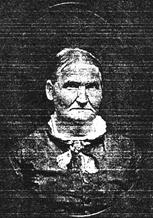Archive for the ‘52 Ancestors’ Category
52 Ancestors in 52 Weeks #26—Martha Hansdatter (1841-1900)
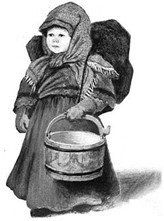 Martha Karoline Dorthea Hansdatter was born on 20 March 1841 on the Dungan farm in Øksnes, a municipality on the large island of Langøya in the county of Nordland, Norway. She was baptized in the Øksnes church in 1841 and confirmed there in 1858.
Martha Karoline Dorthea Hansdatter was born on 20 March 1841 on the Dungan farm in Øksnes, a municipality on the large island of Langøya in the county of Nordland, Norway. She was baptized in the Øksnes church in 1841 and confirmed there in 1858.
Her family included her father, the husmænd Hans Enok/Enoch Pedersen (1813-1898) and her mother, Maren Anna Serina Andersdatter (ca. 1812-1886). Martha had at least one sibling, her brother, Enok Andreas K. Hansen, born about 1850.
In 1861, twenty-year-old Martha gave birth to her first son, Johan Andreas Martinsen, son of Martin Grunbek Kaspersen. No record of a marriage to Martin has been found, but the baby’s patronymic Martinsen tells us that the father must have acknowledged the child.
Martha married Sivert Knudsen several years later on 11 September 1865 in Øksnes parish. The couple and young Johan settled on the Roten farm in Øksnes for a few years before moving on to nearby Valfjord. Only three of the eight children born over the next twelve years survived to adulthood:
- Kaspera Helmine Siversdatter (1866-?)
- Hans Edvard Sivertsen (1870-?)
- Sofie Marie Sivertsdatter (1878-1966)—my great-grandmother.
We know very little about Martha’s life outside of her role as a wife and mother. In 1885 she served as godparent for her granddaughter (Johan’s daughter) Olina Johansen.
Martha passed away on 21 October 1900 at the age of fifty-nine. She barely outlived her father Hans Pedersen who had died a couple of years before. Martha died from a lung problem, perhaps asthma or tuberculosis. Because the ground had already frozen at the time of her death, she was not buried until the next spring on 20 May 1901.
We cannot visit her grave today. In Norway, burial sites are rented for just 20 or 30 years. The rental contract can be renewed up to three times if the community has no immediate need for the grave. Once the family stops paying the rent or the contract expires, the headstone is removed, and the gravesite is reused. Today, we know Martha only through the Øksnes parish records. Her American grandchildren, all born after her death, knew next to nothing about her.
52 Ancestors in 52 Weeks #25—Sivert Knudsen (1843-1907)
 In Norway’s Nordland County, on the Vesterålen archipelago, the Øksnes municipality covers part of the large island of Langøya as well as many smaller islands north of there. Bø and Sortland municipalities share Langøya with Øksnes.
In Norway’s Nordland County, on the Vesterålen archipelago, the Øksnes municipality covers part of the large island of Langøya as well as many smaller islands north of there. Bø and Sortland municipalities share Langøya with Øksnes.
The Øksnes Church, built in 1703, stands on one of the small islands, Skogsøya. The actual parish grounds have been maintained since the 1400’s, and parts of the present church building date to the 1600’s.
Sivert Knudsen was born in this parish at Roten farm, probably on 23 July 1843, to Knud Sjursen and Brita Kristoffersdatter. The date is questionable because his baptism record does not provide a birth date, and subsequent records give conflicting information. Sivert’s confirmation record, arguably the most reliable record, (because the information likely would have been provided by his parents) gives the 23 July 1843 date. Sivert’s youngest daughter Sofie’s baptism registration offers an earlier birth year of 1842. His death record gives a third birth date of 3 June 1843. The July date is probably correct given that he was then baptized a month later on 27 August of that year. Norwegian babies were usually baptized shortly after birth.
When Sivert was a small boy, his family moved on to Hadsel parish. Sivert was confirmed there at age 17 on 9 June 1861. Of course, like most Norwegians, he had already received his smallpox vaccination several years earlier in 1856.
Until 1865, Sivert worked to help his father who was a tenant on the Bjørndal farm in Hadsel. That autumn on 11 September he returned to Øksnes and married 24-year-old Martha Karoline Dorthea Hansdatter. They wed in the same Øksnes church where his parents had been married. When Sivert married Martha, he acquired a step-son, Johan.
After Sivert and Martha married, they and her son settled on the Roten farm in Øksnes where Sivert had been born. Sivert made a living as a farmer and fisherman.
The couple lived at Øksnes for three years and began adding to their family. According to family records, they had twelve children in all, including:
- Johan Martinsen (Martha’s son and Sivert’s stepson, 1861- ca. 1889) eventually became a fisherman and married Jakobina Bergite Antonsdatter in 1884. His stepfather Sivert served as his best man. Johan and Jakobina had a daughter, Olina, and two sons, Helmer and Johan. The boys emigrated to America and married sisters, Alfreda and Marie Susag, in North Dakota. Helmer remained in that state where he farmed and raised a large family. Young Johan, who became known as Johnnie Johnsen, moved on to Bremerton, Washington. He, too, had a large family. Tragically, he died in 1947 while fishing in the Gulf of Alaska when he was washed overboard during a storm.
- Kaspera Helmine Sivertsdatter (1866- ), born at Øksnes. She was known as “Mina” by the family, and she married Petter Jentoft Nilsen, a shoemaker, in 1885 at Eidsfjord. They had 8 children and never left Norway.
- Anna Marie Birgitte Sivertsdatter (1868-1869) born at Øksnes, buried at Hadsel.
- Hans Edvard Sivertsen (1870-?), born at Valfjord. He was a fisherman and married Ingeborg Karoline Reinholdtsen in 1894. They had one son, Sydolf Sigvard Hansen in 1894. Hans and Ingeborg never left Norway.
- Karl Nordal Sivertsen (16-25 July 1872) born at Valfjord.
- Unnamed Sivertsdatter, stillborn 11 May 1874.
- Unnamed Sivertsen, stillborn 27 April 1876.
- Sofie Marie Sivertsdatter (1878-1966) born at Valfjord. Sofie married Ole Jørgen Bentsen in 1904 and emigrated to America the next year.
- Unnamed Sivertsdatter, stillborn 21 September 1882.
No record of the remaining reported children has been found.

Valfjord Wildflowers
Eventually the family left Øksnes and relocated to the settlement at Valfjord. By 1900, Sivert was a leaseholder in a fishing operation there. Over the years, he served as a baptism sponsor for several of the grandchildren:
- Johan’s daughter Olina Andrea Johansen baptized at home on Oshaug on 21 June 1885,
- Mina’s daughter Karoline Berntine Pettersdatter baptized 15 July 1888 at Eidsfjord parish, and
- Hans’ son Sydolf Sigvard Hansen baptized at home on 25 November 1894.
Martha passed away in 1900 leaving Sivert a widower. He died at Øksnes a few years later on 10 Dec 1907 at age 64. The ground was frozen so he was buried the next spring on 2 May 1908 at Eidsfjord i Hadsel parish, where his wife had been buried. No cause of death was recorded in the parish records.
52 Ancestors in 52 Weeks #24—Karen Marie Johansdatter (1851-1916)
Karen Marie Johansdatter, daughter of Johan Larsen (1824-1876) and Sara Andrine Möllersdatter (1814-1880) was born on 7 April 1851 at Titternes farm in the Næsna municipality of the Helgeland traditional region of Nordland, Norway. This farm lies on beautiful Dønna island in the part of Nordland county south of the Arctic Circle. There she was baptized at home on 15 June 1851. The Dønna i Næsna parish recorded this event.
She was confirmed at age 16 in the same parish on 23 June 1867. As was the case for most other Norwegians of the time, her confirmation record indicated that she had received the prerequisite smallpox vaccination.
I visited her birthplace on Dønna in 2013:
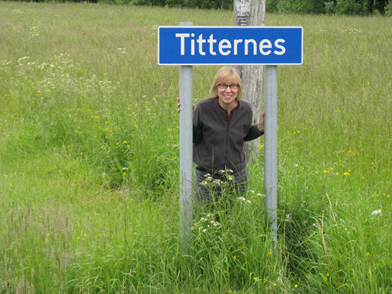
Karen’s family lived on several Dønna farms, ultimately residing on the Skeidsøen farm. They probably lived in modest wooden houses with a grass roofs.
Karen was a middle child in the family. Her siblings included:
- Johana Maria, born 25 September 1845;
- Bergitte Susanna, born 8 September 1848;
- Ludvig Edvard, born 17 May 1855;
- Anne Margrete Kristine, born 12 March 1859; and
- Mortine Lovise, born 19 June 1863.
On 11 August 1873, in Nordland’s Bø parish far away from her home on Dønna, Karen married Lorents Nikolai Möller Bentsen. He was 19 and Karen was twenty-two. How had she ended up in a place that even today is a day’s drive from where she grew up?
Assuming that couples usually married in the wife’s parish, we can surmise that Karen had relocated north to Bø at some point. A couple of explanations come to mind. Perhaps they met when he visited her island on one of his fishing expeditions and she then followed him back to Bø. Or maybe she traveled initially to the Bø area to join relatives or to work and became acquainted with him there. However it happened, the couple settled in Bø after their marriage.
The young bride often saw her family. Her sister Anne’s children, Fresenius and Helga, lived with Nick and Karen in 1900. So did her sister Johana’s granddaughter, Riborg. Perhaps she also met with her father a time or two when he visited the northern area to fish.
Nick and Karen raised their family of two daughters and a son in Bø. Once the children had grown, the two surviving children (Lena and Ole) both decided to emigrate to America, so Nick and Karen followed them in 1905.
They found work in Minnesota to save money for a homestead, and then they moved on to Montana where land was available. They settled in a Norwegian community near Medicine Lake in northeastern Montana.
There they farmed and raised sheep as everyone in Norway had done. In the spring they put their sheep on an island in Medicine Lake so they did not need herding. Karen had brought from Norway her spinning wheel, which would have been a valuable item. She could spin the wool and weave it into cloth to make clothing.
Nick became a naturalized citizen on 10 November 1913 at Plentywood, Sheridan County, Montana. At that time, women could not hold citizenship in their own right. They became citizens of their husband’s country. Karen, then, became a U.S. citizen, too, by virtue of Nick’s citizenship.
After seven years of homesteading, Karen died on 14 November 1916 at age 65. Although the State of Montana had kept death records since 1907, compliance was spotty in the early years, and they do not have a death record for her.
Nick finally acquired title to his own land the spring after Karen died. He received the patent for his homestead from the U. S. government on 25 June 1917. It must have been a bittersweet day without Karen.
With his wife no longer at his side, Nick took steps to sell out. He sold the land and auctioned off their belongings. What became of Karen’s spinning wheel? The family eventually lost track of it, and her granddaughter Signe Bentsen Fleming speculated that it was sold in the auction sale.
When Nick died two and a half years later, he was buried beside Karen at Big Lake [Homestead] Cemetery, not too far from where they homesteaded.
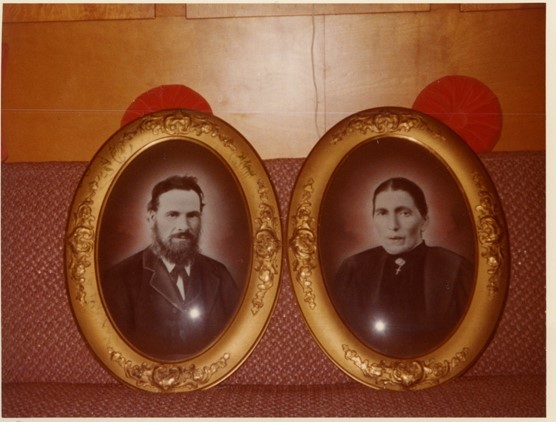
52 Ancestors in 52 Weeks, no. 23—Lorenz Nikolai Bentsen, 1854 – 1919
In the late nineteenth century, the Bentsen clan lived in Bø Municipality on the southern coast of the Vesterålen District of Nordland, Norway. There, on the Fjaervold farm on the island of Langøya, Lorenz Nikolai Möller Andersen was born on 5 July 1854 to Anders Bentsen and Anne Larsdatter. To shorten up this long name, he usually went by “Nick”.
When he was three months old, Nick was baptized into the Lutheran Church of Norway at the Bø parish church built in 1824. The pastor baptized several babies that day, the 16th Sunday after Trinity.
Bø kirke

Nick’s legal name has created some confusion. Our American family records do not match the official Norwegian records recording his name. Nick’s descendants remembered him as “Nikolai Lorenz” rather than “Lorenz Nikolai Möller”. Perhaps they assumed his first name was Nikolai because he went by the nickname “Nick”. They may never have known he had a second middle name because he seems to have dropped it after he came to America.
The descendants also knew him by the “Bentsen” surname he adopted when he immigrated to the United States. In Norway he had used the patronymic name, “Andersen”, derived from his father’s first name, rather than a surname. Norway did not require surnames until the 1920’s, long after Nick had left.
When Nick was born, his family consisted of his parents and an older sister, Kristine Andrea Andersdatter, born in 1851. An unnamed younger brother was stillborn in February 1857.
According to the Norwegian records, Nick’s father was Anders Bentsen (1823-1857). This lineage differs from what Nick’s granddaughter, Signe Bentsen Fleming, has reported in her book Bentsen-Sivertsen History 1800-1988. She states that Nick’s father was a man named Peter Kolbentsen.
Which is correct? Every Norwegian record lists Nick’s patronymic name as “Andersen”, not “Petersen”, indicating that his father’s name was in fact Anders, not Peter. Nick’s baptism, confirmation, and marriage records all report his father’s name as Anders Bentsen. Furthermore, both Nick and his son Ole took the surname Bentsen, not Kolbentsen, when they immigrated to the United States. Indeed, Ole and his sisters had used the Bentsen surname name occasionally even in Norway. It seems likely that Nick’s father was in fact Anders Bentsen. More research remains to be done on the identity of Peter Kolbentsen and his relationship to the family.
Nick’s father passed away in 1857 when the boy was just three years old. By 1865 Nick and his sister Kristine were living on different farms as foster children. “Necolai Andersen”, age 12, lived that year on the Svinøen farm owned by Nils Holgersen. Nick was listed in the household of Anders Grægusen (who had been one of his baptism sponsors) and his wife Andrea Krane.
A couple of years later on 30 May 1869 Nick was confirmed in the same Bø parish where he had been baptized. He was 14 years old. The record indicates he had received his smallpox vaccination four years earlier, in 1861.
On 11 August 1873, again in Bø parish, Nick married Karen Marie Johansdatter, daughter of Johan Larsen (1824-1876) and Sara Andrine Möllersdatter (1814-1880). Nick was 19 and Karen was twenty-two.
The couple lived on the remote island fishing village of Skjæringstad in Vesterålen, Nordland. Over the next several years they moved around to Svinøya and ultimately to Hadsel. Nick engaged in the treacherous fishing industry in addition to his farming work

Skæringstad
During this time, they had at least four children:
- Peter Andreas Norum Lorentzen, born 13 September 1874 at Barstrand Farm. He was baptized 11 October 1874 but does not appear on the 1875 census, so he probably died in infancy.
- Lina Andrea Bentsen, born 29 January 1876 at Skæringstad. Lina worked as a seamstress until she was 28, and then she married Johan Jorgen Kristian Johansen in Hadsel in 1904. They moved on to Troms and had one daughter named Betty Karoline on 23 October that year. Nick and Karen both served as baptism sponsors for Betty. Lina’s family emigrated to the United States in 1909 and settled in Seattle. Johan disappears from the record after that, and Lina then married Emil Torbergsen in 1915. She died in Seattle at the age of 55 in 1932. Her daughter Betty married twice, first to James E. Harrigan about 1925 and then to Howard Cummings in 1949. Betty and Howard lived on Langley Island near Seattle, and there she came to a terrible end in 1954. While driving home from work one day, Howard heard on the radio that his 49-year-old wife had been found brutally murdered in the woods behind their home. A teenaged boy was tried for the crime but was acquitted. Later, a local handyman confessed to the murder.
- Riborg Oline Bentsen, born 18 April 1878 at Skæringstad. Riborg died in Hadsel parish on 13 July 1894 at the age of sixteen. The parish record does not give a cause of death.
- Ole Jörgen Bentsen, born 6 September 1880 at Svinøya. In 1904 Ole married Sofie Marie Sivertsdatter at Hadsel. Nick served as a baptism sponsor for their first child, Riborg Marie Hansene, on 23 October 1904 in the same parish. Interestingly, Riborg was baptized the same day her cousin Betty was born. Riborg’s baptism record gives her father’s residence as “Amerika”. By then, Ole had already emigrated to make a new home for his family. Sofie and the infant Riborg joined him the following spring.
By 1905, then, what was left in Norway for Nick and Karen? They were 51 and 54 years old, no longer young, living the hard, hard life of most Norwegians. They had buried two children in Bø. Their daughter had moved to Troms and perhaps already was making the plans for her eventual emigration in 1909. Their only surviving son and their nephew Fresenius had already gone to America.
In addition to these local concerns, big changes were in the wind in Norway that year. After nearly a century of Swedish rule, Norway achieved its independence that May. Uncertainty lay ahead. With no close familial ties in Bø, and facing life under a new and untested monarch, Nick and Karen made the decision to leave. They were expatriated from the Lutheran Church of Norway on 2 September 1905.
They emigrated at the end of the month on 30 September 1905. Traveling under the “Andersen” surname on the steamship Salmo from Trondheim, they changed ships in Liverpool, England and sailed on to Montreal on the Parisian. From there they took the Canadian Pacific Railway to the U. S. port of Sault Sainte Marie. On 21 October 1905 they headed for Lake Park, Minnesota to join their son Ole and his family.
Nick worked alongside Ole on the railroad in Minnesota. Over the next couple of years, they must have carefully saved their money while they searched for an opportunity to acquire the free land they craved.
During this time, in Becker County, Minnesota, Nick pursued American citizenship. The Declaration of Intention papers he filed on 28 December 1907 described him as five feet, nine inches tall, 180 pounds, with light complexion, grey hair, and dark brown eyes.
In 1908 Nick and Karen again followed their son’s family, this time to a Scandinavian community in Montana. The town of Homestead was a Great Northern Railroad stop on the Big Muddy River south of Medicine Lake. The elder Bentsens moved in with Ole and his family in a 2-room sod house. Nick located a likely homestead, and that summer Ole helped his dad build a house on this land, the NE/4 of Section 8, T30N, R56E, Montana Meridian.
The next spring Nick began farming his intended homestead, a quarter section (160 acres) located a mile away from Ole’s place. He broke 20 acres for flax that year. On 29 June 1910, when he was 55 years old, Nick officially filed for his homestead at the Government Land Office in Glasgow, Montana. Each year after that, Nick broke 10-23 more acres until 1916 when he was farming 100 acres of flax, oats, and wheat.
He and Karen also raised sheep as everyone in Norway had done. In the spring they put their sheep on an island in Medicine Lake so they did not need herding.

A Sheep on Langøya

Island in Medicine Lake, Montana
As an experienced fisherman who was familiar with the seafood business, Nick began importing frozen fish from Seattle, Washington. Once a week he would leave early in the morning by team and wagon to pick up the shipment at the railroad station in Culbertson, Montana. He sold fish to settlers as he traveled northward on the way home.
Nick became a naturalized citizen on 10 November 1913 at Plentywood, Sheridan County, Montana. Nick finally acquired title to his own land in 1917. He received the patent for his homestead from the U. S. government on June 25 of that year.
Unfortunately, his wife Karen had passed away the previous autumn. With her no longer at his side, Nick took steps to sell out. He sold the land and auctioned off their belongings.
When the sale was over, Nick left the land he had worked so hard to acquire. He lived the remainder of his life with his son Ole, who had relocated to a larger homestead south of Redstone, Montana. Less than two years later, Nick died on April 25, 1919 at 64 years of age. The State has no record of his death.
After a lifetime of hard work, Nick had finally possessed a farm of his own only to give it all up. He and Karen had no time together to enjoy it. They are now buried side-by-side at Big Lake [Homestead] Cemetery, not too far from where they homesteaded.
52 Ancestors in 52 Weeks no. 22—Olive Hall Dunbar (1823-1902)
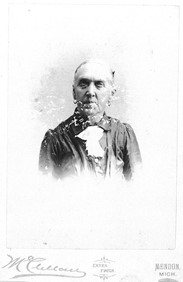 My Grandma Grace probably never met her Grandma Olive. Grace grew up in rural western Nebraska. She never mentioned a visit from her grandmother, nor did she speak of traveling to visit her.
My Grandma Grace probably never met her Grandma Olive. Grace grew up in rural western Nebraska. She never mentioned a visit from her grandmother, nor did she speak of traveling to visit her.
Olive had traveled, though. She lived in three states, Massachusetts, Ohio, and Michigan. Born at Chatham, Massachusetts, on Cape Cod, on June 10, 1823, she was the 10th child of seafarer and salt maker Benjamin E. Dunbar and his wife Rhoda Hall. They lived on the Cape until Olive was about eight years old.
At that time, in the early 1830’s, the market for salt made from sea water had dwindled. The Dunbars sold their holdings and moved inland to then-Portage County, Ohio. They settled in Stow, and the father died soon after their arrival.
Olive probably never saw the ocean again. She and a couple of younger sisters grew up in the home of her widowed mother, surrounded by her older siblings and their families. Her father left her some town property, so a prominent local man became her guardian and watched over her estate. By the time she was nineteen, she had met someone to marry.
She and John Davis Riddle probably were wed on January 7, 1843 by a Justice of the Peace in Summit County, Ohio. Curiously, their names on the marriage record do not match those on other records they created through their lives. He signed as “John Davis”, omitting his Riddle surname. She gave her name as “Olla” rather than Olive.
Olive’s first two daughters, Tamson and Theodocia, were born in Ohio in 1845 and 1847, respectively. John and Olive probably farmed in Summit County.
A few months after Theodocia’s birth, Olive sold her inherited town lots. She and John left for Michigan where they acquired a farm and added to their family. They lived the rest of their lives near Mendon, Michigan. Together they had eight children and also raised one of their grandsons:
- Tamson Rebecca (1845-1922)
- Theodocia Orlinda (1847-1929)
- Isaac Newton (1849-1915)
- Ethan Henry (1851-1931)
- Laura Ruamy (1853-1933), my ancestor
- John Hoxey (1855-1937)
- Seymour Alfonso (1858-1934)
- Olive Delila (1865-1947)
- Aden Ralph (1867-1947), Tamson’s son
Olive reportedly worked hard as farm wife. Her grandchildren recalled that she kept a spotless kitchen floor, scrubbing it daily.
By 1890, the children had grown up. Three of them, Theodocia, Laura, and Seymour, left Michigan to homestead in Nebraska. Did Olive ever see them again?
The passing years did not treat John and Olive kindly. His vision failed, making farm work difficult. The couple finally made a pact for their care with their oldest son Newton. If he remained single, worked their farm, and cared for them, he would eventually inherit the property. Unfortunately, they did not reduce this agreement to writing.
After John committed suicide by hanging himself in his barn in 1896, Olive continued to live on the farm with Newton. When she passed away in 1902, he assumed the farm would be his.
His brother Ethan thought otherwise. He sued his brother for his share of the farm. Because there was no written agreement giving the farm to Newton, Ethan won.
Olive’s farm was sold at auction. Newton received $1174.88 in recognition of his care for his parents, and the other children each received $43.14. Olive’s property had consisted of bushels of wheat, rye, corn, hay, and oats; two cows and a calf; 25 chickens; 16 bed quilts; a feather bed; 4 pillows; 4 cotton bed sheets; a feather tick; table linens; crockery and tin ware; a churn; a milk safe; a clock; 10 chairs; a cooking stove; a rag carpet; an extension table; and 8 framed pictures.
Olive was laid to rest in the Mendon Cemetery, next to John, on June 3, 1902.
52 Ancestors in 52 Weeks, no. 21—John Davis Riddle (1821-1896)
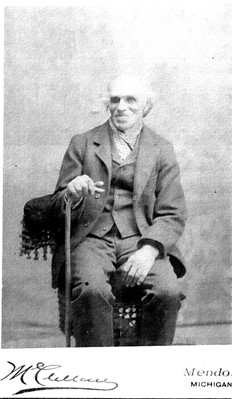 Somewhere in Pennsylvania, a baby boy named John Davis Riddle was born to unknown parents in May, 1821. Family records give the date as May 10, but his cemetery marker says May 15. He was often known as J. D.
Somewhere in Pennsylvania, a baby boy named John Davis Riddle was born to unknown parents in May, 1821. Family records give the date as May 10, but his cemetery marker says May 15. He was often known as J. D.
We know nothing about J. D.’s childhood or where he spent it. The first record of him appears in Summit County, Ohio when at the age of 21 he married Olive Hall Dunbar on the 12th of January, 1843. Oddly, the name on his marriage record is simply “John Davis”, not John Davis Riddle.
J. D. and Olive remained in Edinburgh, Ohio for a few years after their marriage. There they had two daughters, Tamson Rebecca (1845) and Theodocia Orlinda (1847).
The autumn after Theodocia’s birth, the young parents made preparations to leave the state. In September, 1847 they sold land that Olive had inherited from her father, and sometime later they went to find a new home in Michigan.
The couple settled south of the small town of Mendon, Michigan in the southwestern part of the state. They began life as Michigan farm folk, and their first son, Isaac Newton was born there in 1849. Other children followed including Ethan Henry (1851), Laura Ruamy (1853), John Hoxey (1855), Seymour Alfonso (1858), and Olive Delila (1865).
Life was not easy. The Civil War period presented several difficulties. J.D. suffered an accident that resulted in the loss of an eye. In 1867, daughter Tamson became an unwed mother who could not provide for her child. J. D. and Olive took in the boy, Aden, and raised him as their own.
Another tragedy occurred when another grandson, Tamson’s second son Frank Blakesley, died in 1874. The four-year-old died of burns suffered while playing in hot spots where brush had been burned on the Riddle farm the previous day.
After that, J. D.’s troubles continued. He developed a cataract in his remaining eye. By 1880, the U. S. census reported that he was blind. Somehow, he continued with his farm, probably with the help of his son Newton.
The years went by. In 1896, he was 75 years old and could take it no more. On August 16, 1896, a despondent J. D. hanged himself in his barn. It was said he feared poverty.
John Davis Riddle was buried in the Mendon Cemetery. His widow, Olive, and all his children survived him.
52 Ancestors in 52 Weeks, nos. 19 & 20
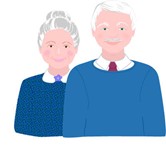 I wish I knew the identity of my ancestors no. 19 & 20. I wonder if they ever knew they had a little granddaughter named Grace born on the Nebraska prairie in August, 1896.
I wish I knew the identity of my ancestors no. 19 & 20. I wonder if they ever knew they had a little granddaughter named Grace born on the Nebraska prairie in August, 1896.
Their son, my mystery great-grandfather, would have spent time with my great-grandmother, Laura Riddle, during the holiday season of 1895. Who was he? How well did they know one another? Did he know about his little girl?
Other than his whereabouts at the end of 1895, my only other information about this man consists of a guess as to his heritage. The clue comes from an autosomal DNA test.
My dad, one of the man’s grandsons, took a DNA test and learned that nearly a third of his DNA comes from northern Europe. Because all his known ancestors immigrated from the British Isles, the man who contributed 25% of his DNA must have been the source of most of the European heritage. German, perhaps?
I keep hoping for an unexplained DNA match that points to a relative of my mystery man. If a close match to an unknown line ever turns up, I hope to discover his identity, and that of his parents. Until then, I will know them only by their numbers, 19 & 20.
52 Ancestors in 52 Weeks No. 18—Katherine S.
 Katherine, Katherine. Who were you and where did you come from?
Katherine, Katherine. Who were you and where did you come from?
This ancestor of mine reportedly died in Indiana right after the Civil War. My family knows virtually nothing about her. All the information I have came from my great-aunt, Bertha Reed Evert, who was our ancestor’s granddaughter. Bertha was born twenty years after her grandmother died, so anything she knew was hearsay.
She told this story: Katherine Staninbaugh/Stanabaugh/Stillenbaugh Sherman was a German girl who immigrated to the U.S. when she was eight years old. She married Thomas Sherman during the Civil War. She died in Indianapolis shortly after the 1865 birth of her daughter and only child, Anna Petronellia, Bertha’s mother.
That’s all we know. No record of her marriage, death, or burial has been found. Nothing is known of her birth family or where they may have lived besides Indianapolis.
We do know that the Shermans resided for a time during the 1860’s in a small community south of Indianapolis, in Johnson County, Indiana. They had German neighbors named Stilgenbauer. Was Katherine one of them?
Several cousins and I have spent years trying to unravel this mystery. Despite our diligent efforts, we have found no clues as the identity of our mysterious Katherine. My Dad’s DNA test tells us he has some northern European ancestry although he is mostly English, so some German ancestry for him would make sense. He received 1/8 of his DNA from our mystery woman.
I find this search for Katherine long and frustrating because we never seem to make any headway. Still, I would really like to locate a family for her, so I will keep working on it.
52 Ancestors in 52 Weeks no. 17: Thomas Sherman (1841-1912)
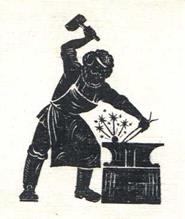 Thomas (Lane?) Sherman always reported on the census records that he was born in Ohio on November 23, 1841, but most of his siblings hailed from the state of Kentucky. The family lived in various Kentucky counties, including Bath, Clark and Madison before and after his birth. His father Daniel worked as a blacksmith, and the sons, including Thomas, all followed him into this profession. Thomas’ precise birthplace in Ohio has not been found, nor is it known why the family briefly resided in Ohio around 1840.
Thomas (Lane?) Sherman always reported on the census records that he was born in Ohio on November 23, 1841, but most of his siblings hailed from the state of Kentucky. The family lived in various Kentucky counties, including Bath, Clark and Madison before and after his birth. His father Daniel worked as a blacksmith, and the sons, including Thomas, all followed him into this profession. Thomas’ precise birthplace in Ohio has not been found, nor is it known why the family briefly resided in Ohio around 1840.
The first record of Thomas outside of the census records appears during the Civil War when his name appears as plaintiff on a court record in Madison County, KY in the case of Sherman v. Raines. Thomas alleged that in September, 1862, Deft Raines had taken a grey horse for use in the Confederate Army. Thomas sued for the value of the horse, $240.
Shortly after this case, the Shermans left Kentucky and relocated to Johnson County, Indiana. There Thomas and his brother Anderson registered for the Civil War draft in June, 1863. Whether Thomas actually served remains unclear. According to his obituary, he had enlisted in Louisville in 1861. No record of his service has been found, nor did he or his third wife apply for a pension based on his service.
Family tradition says that Thomas married for the first time during the Civil War. His bride was said to have been a German girl named Katherine Stillenbaugh or Stanabaugh, but no record of this marriage has been found. Their daughter Anna Petronellia came into the world at Indianapolis in 1865, and Katherine died shortly afterwards.
Thomas’ obituary says he lived at St. Louis after the war, but by 1870 he resided in Hunter Township, Edgar County, Illinois. His four-year-old daughter Anna lived nearby with his mother Rebecca while he worked as a blacksmith in the Fawcett Keyes household. His siblings John, Evaline, and Jasper also lived in Edgar County at the time.
On March 21, 1872, Thomas remarried. His second wife was Mary Scott. They lived with his daughter Anna in Edgar County in 1880 where he continued working as a blacksmith. Mary Scott Sherman disappears from the record after that.
Thomas married for a third time a year later on September 8, 1881 in Moultrie County, Illinois. His wife, Alice Farris, was half his age. The couple appears to have relocated to Missouri after the wedding, and their oldest son Charles Frederick Sherman was born there in 1882.
Afterwards, they returned to Illinois and lived there for the rest of their lives. They had four more children:
- George Raymond, born in Coles County in 1884,
- Ethel, born in Coles County in 1887,
- Claude, born in Cumberland County in 1889, and
- James Walter, born in Cumberland County in 1891.
By 1900, the family had returned to Coles County where Thomas worked as a blacksmith in Seven Hickory and Morgan Townships. Sometime in 1910 he suffered a work-related accident when he was hit in the head with a hammer. This head injury brought on acute insanity, and in May of that year his son George petitioned for his commitment to the Illinois Eastern Hospital for the insane. Thomas was released five months later. When he returned home, the court ordered George and Claude to each contribute $1.50 a week toward the support of their father.
Thomas lived for another year and a half in poor health. He passed away at his home in Charleston, Illinois at the age of seventy on February 3, 1912. He reportedly was buried in the Mound Cemetery in Charleston but the cemetery office there has no record of his interment .
Oddly, his obituary does not name his eldest daughter Anna Petronellia as a survivor. Who provided the information for the obituary? Anna and Thomas’ third wife Alice were said to dislike one another. Was the snub deliberate?
If one of the other children prepared the obituary, perhaps her half-siblings did not really know her and forgot to include her name. Anna had lived far away in southern Missouri since the time of Thomas’ marriage to Alice. Their obituaries did not list Anna as a survivor, either, and they may have lost touch. Yet she seems to have remembered the connection, always keeping photos of them. And she outlived them all.
We have no photos of Thomas, but there may be cousins out there who do. I would love to see them! In the meantime, I do have this photo of three of Thomas’ sons (George, Claude, and Walter) that gives me a clue as to what he may have looked like.
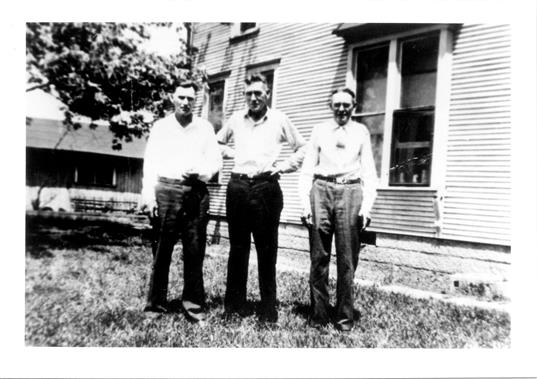
52 Ancestors in 52 Weeks no. 16—Jane Carter Reed (1824-1907)
Jane Carter, also known sometimes as Janete, was born on December 15, 1824 in southern Kentucky. Her parents John Carter and Mary (Polly) Templeton lived along Harmon’s Creek in Wayne County. Jane had 8 surviving siblings: Susan (b.1815), Shelton (b. 1816), Nancy (b. 1818), Bailey (b. 1820), Thena (b. 1823), Joseph (b. 1827), Elizabeth (b. 1829), and Catharine (b. 1832). Her parents moved the family to Ashmore, Coles County, Illinois in 1829 when Jane was still a small child. Her father lived only a few years after arriving in Illinois, passing away in 1841 when Jane was sixteen.
 During Jane’s youth, the Presbyterians held a revival in Ashmore and organized the Cumberland Presbyterian Church. Jane joined that church at the age of 18 and remained a member for 65 years. Perhaps she acquired some of her religious devotion from her mother Mary who on April 15, 1856 presented her daughter with a Bible containing the following inscription: Presented to Jane Reed by Mary Carter, her mother. Daughter this I present to you as the gift of God. And I hope you and Family will read and ponder well the truths contained in it.
During Jane’s youth, the Presbyterians held a revival in Ashmore and organized the Cumberland Presbyterian Church. Jane joined that church at the age of 18 and remained a member for 65 years. Perhaps she acquired some of her religious devotion from her mother Mary who on April 15, 1856 presented her daughter with a Bible containing the following inscription: Presented to Jane Reed by Mary Carter, her mother. Daughter this I present to you as the gift of God. And I hope you and Family will read and ponder well the truths contained in it.
In some ways this was a strange gift because according to census records, none of Mary’s children could read or write. When Mary died a year after presenting the Bible, Jane inherited $39.57, the equivalent of about $1100 today.
Jane married Caleb Reed in Coles County on February 22, 1844. Together they ran a farm and had a family of eleven children. They knew tragedy as three of their young children passed away: Thomas B. at one year in 1854, Mary at age 8 in 1855, and James at age 2 in 1864. Twenty years later they lost two more children: Emma Jane and George both died in 1886. A few years later, one more child predeceased the parents. Albert died in 1890.
At some point, Jane and Caleb retired from the farm and moved into the town of Ashmore. Their daughter Martha lived nearby, and they visited often. After Caleb died in 1903,  Jane lived another couple of years alone. Often after supper, Martha would send her youngest son Hugh Wright over to carry in wood and do other chores for her. He would sometimes spend the night if Jane wished. This went on until he overheard an uncle tell her it was unnecessary to feed Hugh. He promptly left and refused to go back.
Jane lived another couple of years alone. Often after supper, Martha would send her youngest son Hugh Wright over to carry in wood and do other chores for her. He would sometimes spend the night if Jane wished. This went on until he overheard an uncle tell her it was unnecessary to feed Hugh. He promptly left and refused to go back.
Jane spent her last days at the home of Martha and Jim Wright where Martha cared for her. During her final illness no one tried to keep her from knowing that the end was near. She made all her own last arrangements. She asked Mrs. Brown, who lived nearby, to help with her laying out. She wanted the promise that after she was dressed, Mrs. Brown would run her hand beneath her and smooth her dress because “I can’t abide a wrinkle”.
As she breathed her last breaths, she asked her son-in-law Jim Wright and granddaughter Amanda Pearl Wright to sing a hymn. They chose When Our Ships Come Sailing Home. When they thought she was no longer breathing, they stopped, but she roused and commanded them to continue. After a while longer, she died from inanition due to influenza.
After her mother died, Martha wrote this in a letter to one of her daughters: Jane Reed died April 30, 1907 at 15 minutes after 7 o’clock [aged 82 years, 4 months, 15 days]. Her children: Sam, John, Tom, Ida, and Martha were all there. Funeral was at two o’clock May 2, 1907. Her casket cost $130 and the flowers were ten dollars.
Funeral services were held from the family residence, the Rev. Jonathan Williams officiating. She was buried at Ashmore Cemetery next to Caleb.
